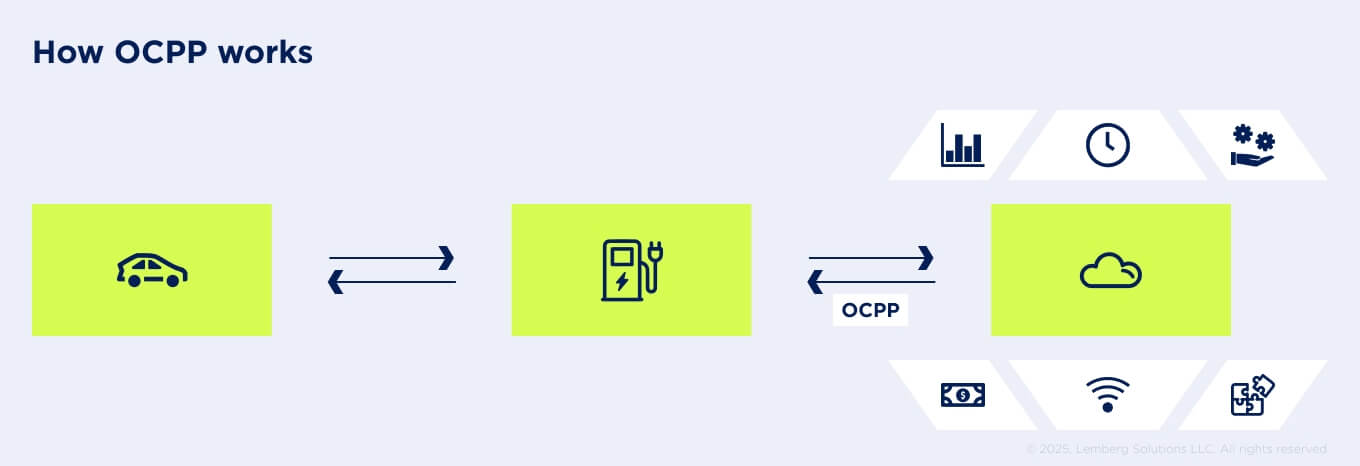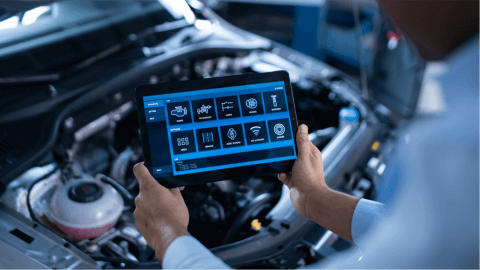OCPP, or Open Charge Point Protocol, is an open communication protocol developed by the Open Charge Alliance (OCA). It enables interoperability and communication between EV charging stations and central management systems (CMS). OCPP enables different brands of chargers and back-end systems to interoperate, thereby reducing vendor lock-in and fostering a more flexible and scalable charging infrastructure.

Currently, there are three versions of OCPP available.
- OCPP 1.6, released in 2015.
- OCPP 2.0, introduced in 2020. Its enhanced version, OCPP 2.0.1 Edition 3, was officially recognized as an international standard (IEC 63584) in 2024.
- OCPP 2.1 launched in 2025.
All three OCPP versions —1.6, 2.0.1, and 2.1 — currently coexist in the market, and in many cases, businesses must either navigate mixed environments or plan for migration. Choosing which version to adopt isn't just a technical decision. It’s a strategic choice that affects product development, operational efficiency, and long-term competitiveness.
Let’s take a closer look at the key benefits, limitations, and adoption trends of OCPP 1.6, 2.0, and 2.1. Whether you're evaluating a transition from OCPP 1.6 to 2.0 or 2.1, deciding which version best fits your new product development, or seeking expert insights, this comparison guide will help you better understand your further steps.
OCPP 1.6 vs OCPP 2.0.1 vs OCPP 2.1 in a nutshell
OCPP 1.6 has been a reliable standard in the EV charging space for many years, providing a solid foundation for charge point operators (CPOs) to efficiently manage and operate their charging networks. Yet, as the EV market expands and charging needs become more complex, this version of OCPP shows its limitations. Some of the primary constraints included limited integration with ISO 15118, constrained online transaction capabilities, a lack of transparency in pricing, restricted data communication, and outdated security protocols. These challenges have driven the need for creating a more robust and feature-rich protocol to support the evolving needs of the EV charging industry.
OCPP 2.0. emerged as a reaction to the above limitations, offering features that met the energy and information security demands.
OCPP 2.0 introduced new functionalities, such as dynamic smart charging, which allows for adjusting charging speeds based on grid load or tariffs, a feature not fully supported in OCPP 1.6. It was later refined and expanded into OCPP 2.0.1, which gained further recognition when it was officially approved as an IEC standard (IEC 63584) in 2024.

The release of OCPP 2.1 marks a new important step forward in the evolution of EV charging standards. The primary motivation for transitioning from OCPP 2.0 to OCPP 2.1 was to enhance the EV charging infrastructure, offering improved functionalities, security, and user experience. Specifically, the key features of OCPP 2.1 include bidirectional charging (V2X), advanced smart energy management, and expanded payment options, which pave the way for a more scalable and efficient charging ecosystem.
Let’s take a deeper look at how OCPP 1.6, 2.0, and 2.1 compare across key features and capabilities.

Comparing OCPP 1.6 vs. OCPP 2.0 vs OCPP 2.1
To help you quickly understand the differences between OCPP 1.6, 2.0, and 2.1, we've put together the table below. For more context, use cases, and expert insights on each version, keep reading the text.
| OCPP 1.6 | OCPP 2.0 | OCPP 2.1 | |
|---|---|---|---|
| ISO 15118-20 support | Limited support | Supports ISO 15118 for Plug & Charge and Smart Charging | Extended ISO 15118-20 support, enabling bidirectional power transfer |
| Compatibility | Not compatible with OCPP 2.0 and 2.1 | Compatible with OCPP 2.1 | Backward-compatible with OCPP 2.0 |
| Security | Basic TLS with username/password authentication; relies on network security layers | Mandatory TLS 1.2+ encryption, built-in certificate management for secure firmware updates | Additional improvements based on community feedback |
| Smart charging | Load balancing and charge profiles | Improved transaction handling, including optimized charging with scheduling to the CSMS | Additional tools for optimized energy distribution, such as scheduled/dynamic control mode |
| Transaction handling | Uses separate messages (StartTransaction, StopTransaction, MeterValues) | Unified TransactionEvent message that streamlines transaction communication | Adds flexible transaction models (fixed-cost, energy, time-based) and session recovery |
| Payment & authorization | Basic RFID and app-based tokens | Supports Plug & Charge, credit cards, QR codes, NFC, and more | Adds prepaid card support, ad hoc payments via credit/debit terminals, and QR code support |
| V2G support | Not natively supported | Partially supported | Introduces bidirectional energy flows, allowing EVs to act as energy sources |
| DER support | Not natively supported | Not natively supported | Enhanced integration with DERs for optimized energy management |
| Battery swapping | Not natively supported | Not natively supported | Support for battery swap stations for two- and three-wheelers and electric vehicles. |
Compatibility
Upgrading from OCPP 1.6 to OCPP 2.0 offered significant improvements in functionality, including advanced transaction handling, smart charging, and security enhancements.
However, the shift isn’t straightforward and has its limitations.
The two versions are technically incompatible, and many older charging stations appeared to lack the hardware capacity to support OCPP 2.0.1. As a result, charge point operators (CPOs) who wanted to upgrade their systems faced a dilemma. They should either fully migrate to OCPP 2.0, replacing the outdated charging points, or run both protocols in parallel, which requires a deliberate transition plan. Maintaining dual systems (different for OCPP 1.6 and OCPP 2.0) can lead to higher infrastructure costs, increased management overhead, and potential inconsistencies in service delivery.
The move from OCPP 2.0 to OCPP 2.1 is much simpler, on the other hand.
These versions are fully compatible, allowing operators to adopt new benefits of OCPP 2.1 without disrupting existing communication. If both the charging station and the backend system support OCPP 2.1, they can fully leverage the enhanced capabilities. If not, the communication defaults to OCPP 2.0 automatically, ensuring continued operation without added complexity. This backward compatibility enables operators to scale and evolve their networks while maintaining stability.
Security
One of the primary drivers for upgrading to OCPP 2.0 from 1.6 was its limited security architecture.
As cybersecurity threats grow more sophisticated, the basic protections in OCPP 1.6, such as simple username and password-based authentication, are no longer sufficient to safeguard EV charging infrastructure. In fact, vulnerabilities in earlier implementations have led to real-world security breaches, highlighting the need for a more resilient protocol. Specifically, a study by the Idaho National Laboratory demonstrated how OCPP 1.6 vulnerabilities can be exploited, highlighting risks such as remote access, spoofing, and injection attacks under weak security configurations.
OCPP 2.0 brought security to a new level. It introduced a dedicated security framework, which included support for TLS-encrypted communication, digital certificate-based authentication (X.509), secure firmware updates, and event-level security logging. These additions enable mutual authentication between the charging station and the backend system, bringing the OCPP 2.0 in line with current cybersecurity best practices.
Building on that foundation, OCPP 2.1 introduced further refinements based on industry and community feedback, enhancing certificate management, improving authentication workflows, and strengthening the protocol’s overall defense against evolving attack vectors.
Smart charging
Smart charging refers to all functionalities that allow the Charge Station Operator (CSO) to control or influence the charging power or current during a session. This includes setting limits on the amount of power or current that the charger can deliver to an electric vehicle.
Imagine an office building equipped with solar panels and experiencing fluctuating electricity costs throughout the day. A smart system would need to adjust charging speed depending on when solar power is available or when energy is cheaper.
OCPP 1.6 sets limited capabilities for smart charging options, as it uses fixed settings for how much power a charging station or connector can use. These settings don’t change based on real-time information, such as electricity prices or the availability of energy.
OCPP 2.0 takes smart charging to a new level by supporting real-time communication and flexible charging control. It allows charging profiles to be updated on the fly based on current grid conditions, electricity prices, or even the vehicle’s charging schedule. Additionally, OCPP 2.0 supports integration with ISO 15118, enabling features such as Plug & Charge for seamless authentication.
OCPP 2.1 introduces tools for even more precise energy distribution, including dynamic and scheduled control modes designed to meet the requirements of ISO 15118-20. These enhancements enable the EV charging station to adjust its charging behavior automatically in response to shifting energy demand or when different vehicles have varying priority levels.
For example, in a parking lot with limited power, the system can prioritize certain electric vehicles (EVs) over others based on urgency or schedule. In addition, OCPP 2.1. offers advanced Vehicle-to-Grid (V2G) capabilities, which allow EVs to return power to the grid. This makes OCPP 2.1 ideal for large-scale deployments where balancing load across multiple vehicles is critical.
Transaction handling
The way charging transactions are handled has evolved across different versions of OCPP.
OCPP 1.6 depends heavily on a stable internet connection to initiate and manage transactions. In areas with spotty or unreliable network coverage, this reliance can result in service disruptions, customer frustration, and potential revenue loss. Moreover, transaction management in OCPP 1.6 is fragmented, meaning it uses separate messages like RemoteStartTransaction, StartTransaction, StopTransaction, RemoteStopTransaction, or MeterValues, which can complicate communication and reduce efficiency.
While OCPP 2.0 did not significantly change how transactions are initiated or completed, it added some enhancements to start/stop mechanisms. Most notably, it introduced the TransactionEvent message, which consolidates various transaction-related actions into a single structure. This shift improves message clarity and reduces communication overhead.
OCPP 2.1 offers more flexible transaction models, including support for fixed-fee, energy-based, and time-based billing. It also adds the capability to resume a session after a station reboot, which is a critical feature for improving service reliability. These additions give charge point operators more control over pricing strategies and help ensure a smoother experience for users, especially during unexpected interruptions.
Payment and authorization
OCPP 1.6 supports basic user authorization methods like RFID cards and remote authorization via the backend system (CSMS). However, it doesn’t include any built-in support for payment processing. Charging station operators have to rely on external systems to handle payments, and there's no support for displaying pricing to users or for modern features like Plug & Charge (ISO 15118).
OCPP 2.0 introduced a more flexible authorization system using IdToken, allowing various user identifiers such as RFID, mobile apps, and certificates. It also added initial support for Plug & Charge, making it easier for vehicles to identify themselves automatically. While it still doesn’t handle payments directly, it provides a better structure for integrating with external payment systems and roaming platforms.
OCPP 2.1 builds on these improvements and takes a big step forward in supporting real-world payment scenarios. It includes a defined interface for external payment terminals (EPTs), the ability to display pricing information to users, and full support for Plug & Charge, as specified in ISO 15118-20. It also enables pre-paid charging and better roaming integration, making it the most payment-friendly version of OCPP.
Vehicle-to-Grid (V2G) support
Vehicle-to-Grid (V2G), or bidirectional power support, refers to a system’s ability to enable bidirectional energy flow between an electric vehicle and the electrical grid. This means that in addition to charging the EV battery, the system can also discharge energy back to the grid, helping to balance supply and demand, support grid stability, or power a local building.
OCPP 1.6 does not support V2G functionality, as it is primarily designed for unidirectional charging (where the vehicle receives power only). Any V2G implementation with OCPP 1.6 would require significant workarounds or proprietary extensions outside the standard protocol.
OCPP 2.0 introduces basic support for V2G, aligned with the early ISO 15118 standard. However, it still lacks some essential features necessary for full V2G implementation, such as comprehensive support for energy metering and contract-based energy delivery.
With the release of OCPP 2.1, support for bidirectional charging was added. The protocol now includes a dedicated functional block for managing energy flows in both directions, allowing seamless communication between charging stations and EVs capable of energy discharge. This advancement unlocks a wide range of opportunities: from grid stabilization and energy market participation to emergency power supply. When paired with ISO 15118-20, bidirectional energy management becomes viable in both residential use cases, such as Vehicle-to-Home (V2H), and public scenarios where electric vehicles (EVs) contribute to grid balancing.

DER support
OCPP 1.6 offers minimal support for Distributed Energy Resources (DER). It enables basic smart charging through features like SetChargingProfile, but lacks the ability to coordinate with local energy sources such as solar panels or batteries. Any DER integration must be handled externally using custom systems. OCPP 2.0 improves on this by introducing enhanced smart charging capabilities, including energy transfer modes and charging needs, laying the groundwork for interaction with energy management systems and limited DER coordination. However, it still falls short of full grid or local resource integration.
With OCPP 2.1, EV charging stations can now function as Distributed Energy Resources (DERs), enabling bidirectional energy transfer. Compliance with local grid codes is mandatory for DERs, which includes responding to specific grid conditions through predefined settings and curves. Utilities can now control these settings through protocols like IEEE 2030.5, making it easier to integrate an EV charging station into the grid. The new OCPP version allows utilities to treat these stations as integral DERs, enhancing the overall reliability of the energy grid.
OCPP adoption trends
Despite OCPP 2.0.1 offering a suite of advanced features, many manufacturers and operators remain hesitant to migrate from the well-established OCPP 1.6. The hesitation largely stems from the high cost and technical complexity of upgrading existing systems, especially since OCPP 1.6 and 2.0.1 are not backward compatible. In essence, moving to 2.0.1 often requires rebuilding core parts of the infrastructure from scratch.
As a result, developers frequently attempt to retrofit OCPP 1.6 systems with selected features from OCPP 2.0. While this may seem like a temporary workaround, it leads to non-standard implementations that increase integration costs and create potential security risks due to protocol inconsistencies. Moreover, as the additional messages in OCPP 1.6 are not standardized, each CSO may implement features from OCPP 2.0 at their own discretion. This creates additional challenges for charger developers. If developers implement functionality tailored to one CSO, it’s unlikely to work seamlessly with another provider’s system.

However, regulatory pressure is shaping the landscape. In the U.S., for example, certain government-funded EV charging projects now mandate OCPP 2.0 compliance, incentivizing operators to upgrade their systems. At the same time, the release of OCPP 2.1, which offers extended support for ISO 15118-20, full V2G functionality, and integration with Distributed Energy Resources (DERs), provides a more future-ready foundation for new development.
A practical recommendation: if you're launching a new product or planning a long-term roadmap, it's often more practical to move directly to OCPP 2.1, rather than investing time and resources in retrofitting 1.6 or partially implementing 2.0. This avoids costly technical debt and positions your infrastructure to meet future energy and grid integration needs.
How can Lemberg Solutions help with OCPP implementation?
At Lemberg Solutions, we bring hands-on experience in implementing OCPP with full support for all required profiles, including Smart Charging, AutoCharge, and Composite Schedule management. Our approach to OCPP implementation also includes active monitoring of system performance, bug fixing, and a deep understanding of protocol logic to ensure stability and scalability. With this experience, we are ready to implement the advanced versions of OCPP, including OCPP 2.0 and OCPP 2.1.
With Lemberg Solutions, you're not just getting a development team but partnering with engineers who understand the core mechanics of OCPP and can guide you through a smooth upgrade path to OCPP 2.0 and 2.1.

FAQs
What is OCPP?
OCPP, or Open Charge Point Protocol, is an application protocol that facilitates communication between an electric vehicle charging station and its management system.
What is the latest OCPP version?
As of now, the latest official version of the Open Charge Point Protocol (OCPP) is OCPP 2.1, which was released by the Open Charge Alliance (OCA) in 2025.
Is OCPP 2.0 backwards compatible?
No, OCPP 2.0 is not backwards compatible with OCPP 1.6 or earlier versions.
This means a charge point management system (CSMS) or backend using OCPP 2.0 cannot directly communicate with a charging station running on OCPP 1.6, and vice versa.
OCPP 1.6 vs OCPP 2.0.1: which suits your business needs?
OCPP 1.6 is reliable for standard charging operations and is recommended for supporting existing charging stations. OCPP 2.0.1 introduces advanced features such as smart charging, enhanced security, and ISO 15118 support, making it ideal for scalable, future-focused solutions.
What role does OCPP 2.0.1 play in public charging stations?
OCPP 2.0.1 provides a standardized, secure way for public charging stations to communicate with back-end systems. It enables advanced features like smart charging, remote monitoring, user messaging, better security, and support for Plug & Charge, making public EV charging more reliable, efficient, and user-friendly.
What is new in OCPP 2.1 compared to previous versions?
OCPP 2.1 introduced the following enhancements in the way how an EV charging station and the CSMS communicate. These include:
- Extended support for ISO 15118-20;
- Bidirectional charging (V2G);
- Dynamic energy management;
- DER support;
- Battery swapping;
- Better session control and transaction models.
What are the main advantages of OCPP 2.1?
OCPP 2.1 introduces support for ISO 15118-20, enabling bidirectional charging (V2G), Plug & Charge, and advanced energy management. It also enhances transaction handling, introduces flexible billing options, supports battery swapping, and improves smart charging, making it ideal for future-ready, scalable EV charging networks.
What is ISO 15118-20 support in OCPP 2.1?
OCPP provides extended support for ISO 15118-20, enabling Plug & Charge, bidirectional charging (V2G), energy scheduling, and integration with smart grids. This allows EVs to automatically authenticate, charge, and even return energy to the grid.








